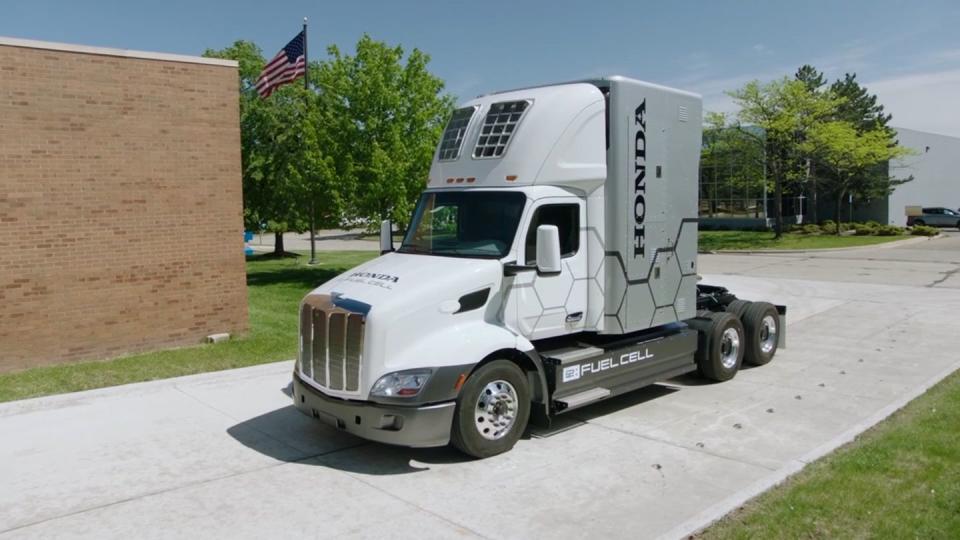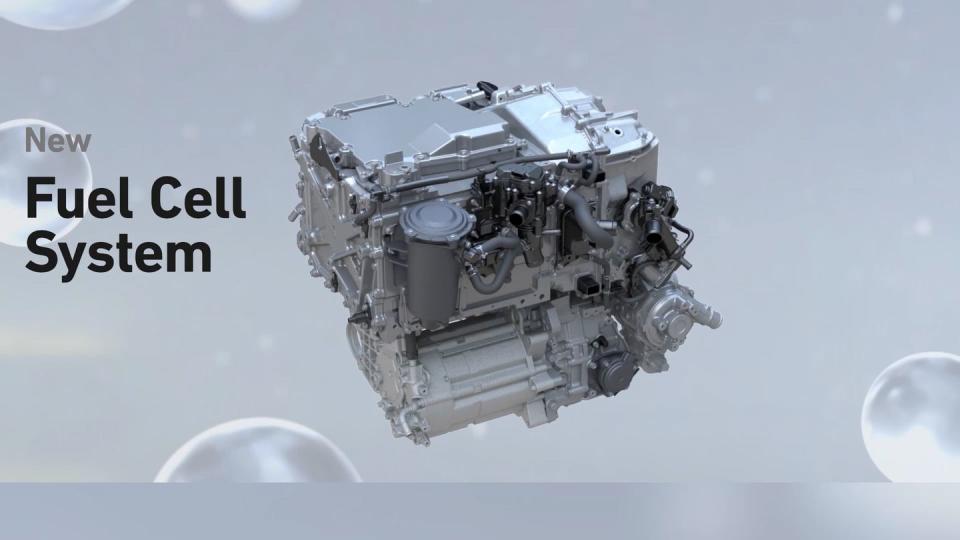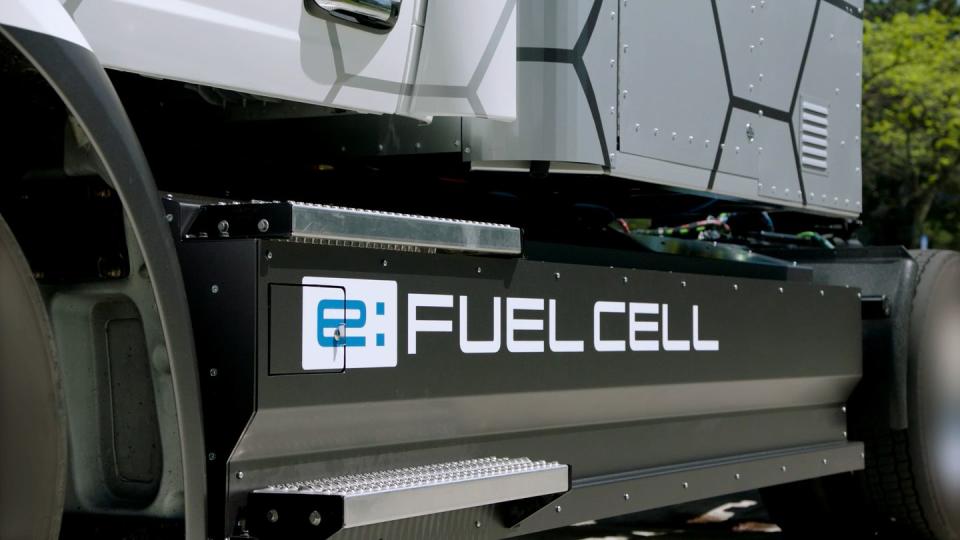Check It Out, Honda’s Fuel-Cell Big Rig, Part of a ‘Hydrogen Future’

Honda debuts its fuel cell-powered big rig at ACT Expo in Las Vegas.
The fuel cells are made by a joint venture with GM.
It’s all part of Honda’s hydrogen business strategy “to increase the use of hydrogen fuel-cell technology as the company looks to expand its hydrogen business and achieve its global goal of zero environmental impact.”
Almost exactly a week after Toyota highlighted its hydrogen plans for H2-fueled big rigs, a stationary fuel powerplant, and the continuing presence in the market of its Mirai passenger FCEV, Honda has done pretty much the same thing.
At this weekend’s Advanced Clean Transportation Expo in Las Vegas, Honda will announce a fuel cell big rig of its own, along with a display of other zero-emission products, including an Autonomous Work Vehicle prototype and the all-new 2025 Honda CR-V e:FCEV.
Last year, Honda and Isuzu showed off a Fuel Cell-Powered heavy-duty Truck at the Japan Mobility Show that had a range of more than 500 miles. The new truck shown here is completely different from last year’s.
The “Class 8 Hydrogen Fuel Cell Truck Concept” is powered by three new, Honda fuel-cell systems, which are now in production at Fuel Cell System Manufacturing, LLC, a joint venture production facility with GM in Brownstown, Michigan. The new FC modules that power the new truck lower the cost by two-thirds compared to, for instance, the fuel cells in the now-retired Honda Clarity Fuel Cell passenger car.

The big rig is key to the Honda hydrogen business strategy outlined earlier this year on January 25. That strategy is “to increase the use of hydrogen fuel-cell technology as the company looks to expand its hydrogen business and achieve its global goal of zero environmental impact, including carbon neutrality for all products and corporate activities by 2050,” Honda said.
(Honda’s fuel cell partner GM has said it plans to make hydrogen fuel cell-powered medium-2duty trucks.)
Just as Toyota outlined last week, Honda’s hydrogen plans go well beyond just fueling big rigs and passenger vehicles.
“Our new fuel-cell system is at the core of Honda hydrogen technology and our strategy to expand the range of applications that use hydrogen to facilitate the decarbonization of society,” said Jay Joseph, Honda’s vice president of sustainability and business development. “This is not simply a choice between battery electric or hydrogen fuel cell technology, but selecting the right energy source, in the right place, for the right purpose, to achieve carbon neutrality as quickly and efficiently as possible.”

The new fuel cell is key to that strategy, Honda said. Both Honda and GM have been working on it for the last decade, and it’s a big step. “The new Honda fuel cell system advances performance and doubles durability while reducing cost by two-thirds compared to the previous generation system,” Honda said.
The company points out that it has been conducting research and development of hydrogen technologies and fuel-cell electric vehicles (FCEV) for more than 30 years.
But it’s not just the big rig. Honda has identified four core domains for the initial utilization of its new fuel-cell system: fuel-cell electric vehicles (FCEVs), commercial fuel-cell vehicles, stationary power stations, and construction machinery. Specifically for the ACT Expo in Las Vegas that means Honda will show off its:
Class 8 Hydrogen Fuel Cell Truck Concept
2025 Honda CR-V e:FCEV production plug-in hydrogen fuel-cell electric vehicle introduced in February and set to go on sale this fall with an EPA driving range of 270 miles total, 29 of which can be on electricity stored in onboard batteries. Honda points out that it’s the only FCEV with plug-in battery power to augment the hydrogen-powered fuel cell.
Honda Autonomous Work Vehicle (AWV), a prototype, all-electric off-road vehicle designed to enhance worksite efficiencies and support repetitive tasks. It was introduced two months ago at the construction trade show CONEXPO also in Las Vegas. At that show Honda enlisted beta testers to try it out.
There was no mention of a stationary power station for the ACT Expo show stand.
But it’s the hydrogen fuel-cell-powered big rig that’s no doubt the star of the show this weekend. The big rig is 315 inches long, 95 inches wide, and 158 inches high. It can carry 8,208 pounds GCW, gross combined weight (the maximum weight a vehicle can safely carry, including the weight of its cargo, passengers, and trailer).
Honda estimates driving range of 400 miles from a single tank capable of holding 181 pounds of hydrogen at 10,000 psi. The concept truck also has a 120-kWh battery that could power the electric motors to make it go forward. Top speed is 70 mph.
“By utilizing our new fuel-cell systems to replace existing diesel applications, we can both help reduce emissions for multiple industries and expand the demand for hydrogen in North America,” Honda said.
Unlike Toyota, which at least debuted a single clean and green biomass-fueled refinery that converted natural gas to hydrogen to power its fleet of Class 8 trucks, and GM, which, through a microgrid project, will create green hydrogen at off-peak hours, Honda made no mention of where and how it will get its hydrogen.
Right now almost all commercially available hydrogen comes from reformation of natural gas, an energy intensive process that releases CO2 into the atmosphere. Looking forward to hearing more on that at a later date, as is the rest of the industry.

 Yahoo Autos
Yahoo Autos 